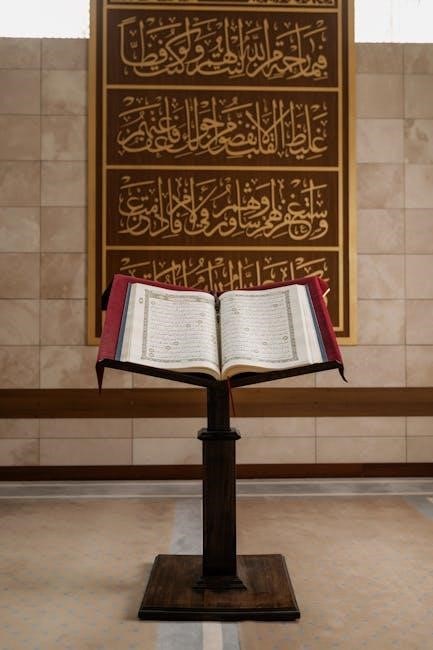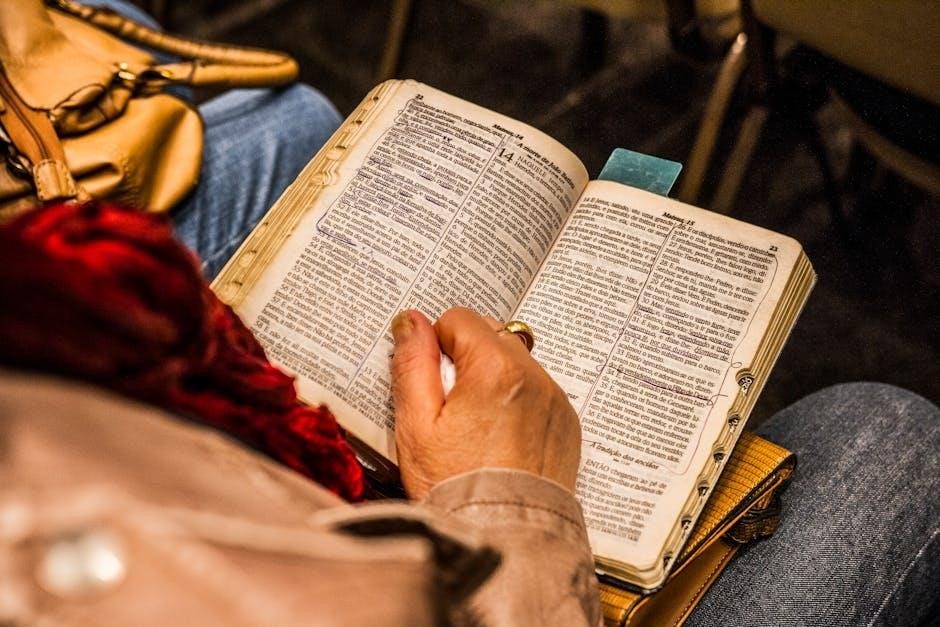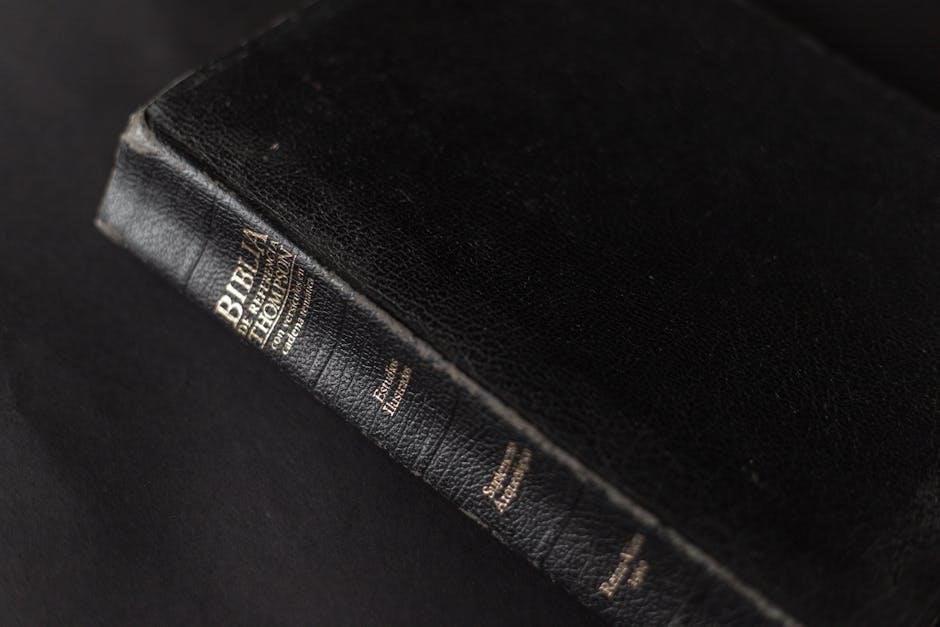Yom Kippur, the Day of Atonement, is Judaism’s holiest day, focusing on repentance and forgiveness. The Machzor, a specialized prayer book, guides worshippers through its unique services and rituals, offering prayers, confessions, and readings that reflect the day’s spiritual significance. Its structure and content are designed to help individuals connect with the divine, seeking pardon and renewal. The Machzor is a vital companion for navigating Yom Kippur’s profound liturgy and traditions.
1.1. What is Yom Kippur?
Yom Kippur, the Day of Atonement, is the holiest day in the Jewish calendar, observed on the 10th day of the Hebrew month of Tishrei. It is a day of profound reflection, repentance, and seeking forgiveness for sins committed during the past year. Jews around the world fast for 25 hours, abstaining from food and drink, and engage in intensive prayer to reconnect with God and their communities. The day emphasizes personal and communal accountability, with a focus on spiritual cleansing and renewal. Central to the observance is the belief that God judges individuals on this day, and sincere repentance can lead to forgiveness. The prayers and rituals of Yom Kippur are profoundly moving, making it a cornerstone of Jewish spiritual life.
1.2. The Role of the Machzor in Yom Kippur Services
The Machzor serves as the essential prayer book for Yom Kippur, guiding worshippers through the day’s unique and complex liturgy. It contains specific prayers, confessions, and readings tailored to the themes of repentance, forgiveness, and spiritual renewal. The Machzor is structured to follow the sequence of Yom Kippur services, including Kol Nidrei, Morning, Torah, Yizkor, and Neilah. It provides the necessary text for both individual and communal recitation, helping participants navigate the emotional and spiritual journey of the day. By offering both Hebrew text and English translations, the Machzor ensures accessibility for all, making it a vital resource for meaningful participation in Yom Kippur observances.

Structure of the Yom Kippur Prayer Book
The Yom Kippur prayer book is divided into several key sections: Kol Nidrei, Morning Services, Torah Services, Yizkor Memorial Service, and Neilah Closing Service.
2.1. Evening Services (Kol Nidrei)
Kol Nidrei marks the beginning of Yom Kippur, with the haunting chant of the Kol Nidrei prayer, symbolizing the annulment of vows. This solemn service, conducted in the evening, sets the tone for the Day of Atonement. The prayer book, or Machzor, includes the Kol Nidrei declaration, which is recited three times, and a special Torah reading. The service also features confessional prayers, known as Vidui, where worshippers reflect on their actions. Many congregations use digital versions of the Machzor, available as PDF downloads, to follow along with the prayers and readings. This service emphasizes spiritual preparation and the pursuit of forgiveness, aligning with Yom Kippur’s themes of repentance and renewal.
2.2. Morning Services
The Yom Kippur morning services, known as Shacharit, continue the themes of repentance and forgiveness. The Machzor includes the Amidah prayer, specifically adapted for Yom Kippur, which emphasizes atonement and divine mercy. The service also features the recitation of the Shema, a central declaration of faith, and a detailed Torah reading. The Torah portion often includes themes of sacrifice and atonement, reflecting the day’s purpose. Many congregations use digital versions of the Machzor, available as PDF downloads, to enhance participation. The morning services build on the evening’s solemnity, deepening the spiritual journey toward forgiveness and renewal, and preparing worshippers for the day’s continued observances.
2.3. Torah Services
The Torah services on Yom Kippur are a central part of the day’s observances, with readings that emphasize atonement and divine forgiveness. The Machzor includes specific Torah portions, such as Leviticus 16, which details the ancient rituals of atonement performed by the High Priest, and Isaiah 57-58, which calls for repentance and ethical living. These readings are accompanied by Haftarot that reinforce themes of forgiveness and redemption. Digital versions of the Machzor, available as PDF downloads, often include commentary and translations to enhance understanding. The Torah service serves as a bridge between historical rituals and contemporary spiritual reflection, deepening the community’s connection to Yom Kippur’s core values.
2.4. Yizkor Memorial Service
The Yizkor Memorial Service is a poignant part of Yom Kippur, honoring the memory of loved ones who have passed away. Found in the Machzor, it includes prayers like El Malei Rachamim and Shalom Rav, which seek comfort and peace for the souls of the departed. Yizkor is recited during the afternoon service and is a time for reflection and connection with those who have passed. Digital versions of the Machzor, available as PDF downloads, provide access to these prayers, enabling individuals to participate even if unable to attend in person. The service offers solace and strengthens the bond between the living and the deceased, emphasizing the enduring nature of memory and love.
2.5. Neilah Closing Service
Neilah, the final service of Yom Kippur, marks the closing of the holiday with a sense of urgency and hope. The Machzor guides worshippers through this emotional conclusion, featuring prayers like El Nora Alila and the recitation of Shema Yisrael. As the gates of repentance are believed to close, the congregation fervently seeks a final sealing in the Book of Life. Digital versions of the Machzor, available as PDFs, include the Neilah service, allowing for participation from any location. The service culminates with the sounding of the shofar, signaling the end of the fast and the beginning of the new year with renewed spirit and purpose.
Key Prayers and Readings in the Machzor
The Machzor includes essential prayers like Al Cheyt, Shema, and Amidah, focusing on forgiveness and divine connection, with digital versions available as PDFs for accessible worship.
3.1. Al Cheyt Confessional Prayer
The Al Cheyt prayer is a central confessional in the Yom Kippur Machzor, enumerating sins seeking forgiveness, both individually and collectively, emphasizing human frailty and divine mercy, found in PDF versions of the prayer book.
3.2. Shema and Its Significance
The Shema, a foundational Jewish prayer, is central to Yom Kippur services, affirming faith in one God. Its recitation in the Machzor emphasizes divine unity and loyalty. Traditionally, the congregational response to the Shema, “Baruch shem kvod malchuto l’olam va’ed,” is whispered, but on Yom Kippur, it is spoken aloud, symbolizing collective devotion and atonement. This practice reflects ancient Temple rituals, where high holy day ceremonies were conducted publicly. The Shema’s inclusion in the Machzor underscores its role in seeking forgiveness and renewal, aligning with Yom Kippur’s themes of repentance and spiritual cleansing. Its presence in PDF versions of the prayer book ensures accessibility for modern worshippers.
3.3. Amidah Prayer with Yom Kippur Text
The Amidah, a central prayer in Jewish liturgy, is adapted for Yom Kippur with specific texts emphasizing atonement and forgiveness. Known as “HaShiva,” it includes pleas for pardon and reflections on human frailty. The Machzor’s Amidah incorporates confessional elements, such as “Ashamnu” and “Al Cheyt,” which enumerate sins and seek divine mercy. This prayer is recited silently, then repeated aloud by the cantor, allowing the congregation to fulfill their obligation. In PDF versions of the Machzor, the Yom Kippur Amidah is often highlighted, ensuring worshippers can follow the unique liturgy. Its structure and content guide individuals through introspection, aligning with the day’s themes of repentance and renewal.
3.4. Vidui (Confession) Prayers
Vidui, or confession, is a central element of Yom Kippur services, featured prominently in the Machzor. These prayers are recited during both the evening and morning services, as well as during Neilah. The Vidui includes two main parts: “Ashamnu,” a alphabetical acrostic listing sins, and “Al Cheyt,” a more personal confession. In the Machzor, these prayers are often printed with transliterations and translations, making them accessible to all. The confessions are recited communally, emphasizing collective responsibility and the shared quest for forgiveness. PDF versions of the Machzor often include these sections with clear formatting, ensuring that worshippers can easily follow along and reflect on their actions throughout the year.
Digital Availability of Yom Kippur Machzor
Yom Kippur Machzor is widely available in digital formats, including PDF downloads and online platforms. Many synagogues offer free PDF versions for convenient access and worship participation.
4.1. PDF Downloads for Yom Kippur Services
PDF downloads of the Yom Kippur Machzor are widely accessible online, offering convenient access to prayer texts. Many synagogues and Jewish organizations provide free downloadable versions, allowing worshippers to follow services seamlessly. These PDFs typically include the full liturgy, such as the Kol Nidrei, Morning, Torah, Yizkor, and Neilah services. Some versions also feature Hebrew-English text, linear translations, and commentary, catering to diverse congregational needs. Additionally, platforms like BShERT synagogue offer downloadable PDFs for specific services, ensuring accessibility for remote participation. This digital format has become a popular choice for those seeking to engage deeply with Yom Kippur prayers and reflections.

4.2. Online Resources and Interactive Machzorim
Beyond PDFs, online platforms offer interactive Machzorim for Yom Kippur, enhancing accessibility and engagement. Websites provide clickable prayer links, commentary, and multimedia features, allowing users to navigate services seamlessly. Digital libraries, such as those from BShERT synagogue, offer downloadable and interactive versions, catering to diverse needs. These resources often include Hebrew-English texts, linear translations, and explanatory notes, enriching worshippers’ experiences. Interactive Machzorim enable real-time participation, especially for those unable to attend in-person services. This digital evolution ensures the timeless traditions of Yom Kippur remain accessible and meaningful in the modern age, fostering spiritual connection and reflection.

Traditions and Customs Reflected in the Machzor
The Machzor reflects Yom Kippur customs, such as wearing white attire symbolizing purity and equality. Fasting and reciting confessional prayers like Al Cheyt and Shema emphasize atonement and divine connection.
5.1. Wearing White on Yom Kippur
Wearing white on Yom Kippur is a meaningful tradition symbolizing purity, equality, and spiritual cleansing. This custom reflects the High Priest’s white garments worn in the Temple, emphasizing humility and divine connection. Congregants often wear white attire, such as a kittel (a simple white robe), to signify unity and a collective pursuit of forgiveness. The color white evokes the imagery of purity and reminds individuals of the desire to present themselves before God in a state of spiritual cleanliness. This practice, deeply rooted in Jewish tradition, underscores the day’s focus on repentance and renewal, aligning with the prayers and reflections found in the Machzor.
5.2. Fasting and Prayer
Fasting on Yom Kippur, known as tzom, is a central observance, lasting 25 hours. It involves abstaining from food, drink, and physical comforts to focus on spiritual reflection and seeking forgiveness. Prayer plays a vital role, with extended synagogue services guiding worshippers through expressions of repentance and divine connection. The Machzor includes specific prayers for fasting, such as Avinu Malkeinu and Selichot, which emphasize mercy and atonement. Fasting and prayer together create a profound opportunity for introspection, unity, and reconciliation, drawing individuals closer to God and their community. This practice, rooted in tradition, underscores Yom Kippur’s purpose of cleansing the soul and renewing spiritual commitment.

The Machzor serves as a spiritual guide for Yom Kippur, helping worshippers seek forgiveness and renewal. Its prayers and readings connect individuals to tradition, community, and the divine, ensuring a meaningful observance of the Day of Atonement.
6.1. The Machzor as a Spiritual Guide for Yom Kippur
The Machzor is a vital spiritual guide for Yom Kippur, providing structured prayers and reflections to navigate the day’s profound themes of repentance and forgiveness. It contains essential liturgy, including the Al Cheyt confessional, Vidui prayers, and the Neilah service, which collectively facilitate introspection and connection to divine mercy. The Machzor’s comprehensive structure aids individuals in expressing remorse, seeking pardon, and reaffirming their commitment to spiritual growth. By following its guidance, worshippers can fully engage with the sacred rituals and emotions of Yom Kippur, ensuring a meaningful and transformative experience.